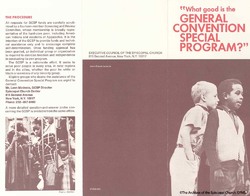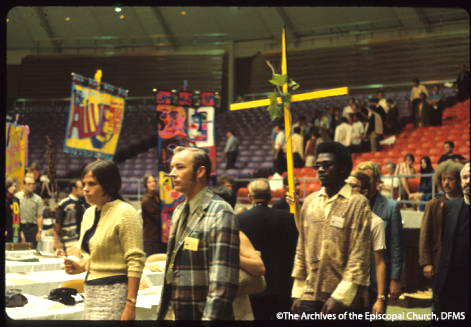General Convention Special Program
The 1969 Special General Convention was a moment of self-recognition when the Episcopal Church confronted its place in public life and tested the theological understanding of the baptismal covenant and the true meaning of catholicity in the diversity of God’s creation. “General Convention II,” as it was first known, was an unusual event in the Church’s historyhistory–only one other Convention, that of 1821, had been called outside of the regular triennial period--and it spotlighted the Church at a time of extreme turmoil, division, and dramatic confrontation with the past.
Following an eye-opening tour of Harlem with African American activists, Presiding Bishop John Hines pushed through the regularly convened General Convention of 1967 a “Special Program” (GCSP). The program was intended to respond to the poverty and injustice of the American ghetto. Executive Council redirected the Church’s funds to community organizations and grassroots efforts aimed at the urban underclass throughout the United States.
The GCSP represented an enormous break with the status quo and past leaders – Black and white. Its potential for change was so important to Bishop Hines that at the 1967 Convention, Hines planned for a special Convention to continue and monitor the progress of the GCSP. The General Convention of 1967 also requested that the Special General Convention include additional delegates to ensure that youth, women, and minority groups be represented. Recognizing an opportunity to alter power relationships and representation, the women of the Church, notably through a realized pledge of three million dollars raised by the venerable United Thank Offering, were the earliest to respond favorably to Hines’ expanded concept of the Church’s “domestic mission”. [Sources]
Youth representatives at the Special General Convention held in South Bend, Indiana from August 31 to September 5, 1969.

Report produced by the Executive Council of the Episcopal Church updating Church members on the General Convention Special Program, 1968.

In 1967 approximately half of the Black Episcopal clergy, led by the Reverend Quintin Primo, rector of St. Matthew’s Church in Wilmington, Delaware, signed “A Declaration by Priests who are Negroes”. It was addressed to the white leadership of the Church and denounced the second-class treatment of the African American clergy.



